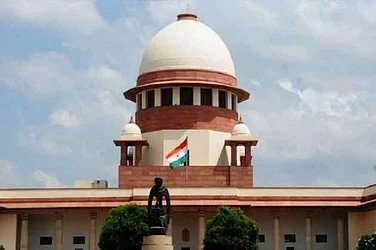Should India, a country of 1.3 billion that, as the United Nations’ 2019 report on world population predicts, will soon overtake China to become the highest peopled nation of the world in 2027, have a population policy that curbs the growth of human numbers? And, if so, what should be the key foundation behind the implementation of such a policy?
The primary rationale offered by the political elite in contemporary India is ‘improving’ the ‘living standards’ of Indian people. Population growth needs to be curbed, the mainstream political leadership, across political parties argues, to nurture and bolster India’s ‘demographic dividend’ – the higher economic growth potential, typical of countries (with a significant number of young people) having a working-age population larger in share than the non-working age population. Consider the ethnonationalist apprehensions of the ruling Bharatiya Janata Party’s members, suggesting that if India kept adhering to the supposedly misplaced legacy of the 1994 Cairo consensus, prioritised the safeguarding of reproductive rights to necessary population-reduction measures, and, therefore, did not enforce a ‘two-child norm’ with immediate urgency, then ‘women will not be safe and might have to be kept under the veil, like in Pakistan’. Or think about the claim made by a bigwig-led group called the ‘Taxpayers’ Association of Bharat,’ since 2017, suggesting that while the norm-abiding taxpayers follow the small-family norm with acute diligence, the ‘non-entrepreneurial’ individuals receiving subsidised food, clothes and housing are reluctant to adhere to it. Or, for that matter, consider the recent framing of the population problem by the opposition leader, Indian National Congress’s Rahul Gandhi, exclusively in terms of whether people of working age are actually working, being ‘productive’ and, therefore, ‘adding value’ or whether this demographic is doing none of this and, consequently, turning into a ‘liability’.
These examples allude to how the Indian state apparatus assumes that the most effective way to conceptualise the population problem is to think in terms of the ‘dividend’, i. e. how to make the ‘surplus’ population ‘valuable’ and ‘productive’, by making it save, invest, and consume. However, in today’s age of an escalating climate crisis and given that India is the third highest emitter of greenhouse gases, it is by now clear that the debate on reducing human numbers in India, cannot be solely about enhancing the lifestyle and the material conditions of living of the Indian people. The population question today has to consider the climate question (i. e. how as a species we are literally under the shadow of the Sixth Extinction) with instant urgency.
Was mainstream political leadership in India ever able to dissociate the question of human number-reduction from the issue of nurturing the ‘demographic dividend’? The answer might have been a resounding yes.
Reading some under-researched speeches and writings of independent India’s first woman prime minister, Indira Gandhi, especially through the prism of some of the ground-breaking conceptual categories offered by historian Dipesh Chakrabarty’s 2021 book ‘The Climate of History in a Planetary Age’ proves this. They reveal that Mrs. Gandhi, often held culpable (and sometimes rightly so) for the forced sterilisation programmes implemented by her son, Sanjay Gandhi, during the infamous period of the ‘National Emergency’, and thereby for ‘emasculating’ men through forced vasectomy programmes, was, during the course of her political career, able to dissociate the urgent question of population reduction from the emphasis on enhancing the ‘demographic dividend’ in a crucial yet under-acknowledged way.

Indira Gandhi linked the problem of unsustainable human numbers to the climate question by simultaneously operating in two (what Chakrabarty identifies as) heterogeneous registers of thought. First, a short-term register of ‘anthropological difference’ where the subject of population is mainly a question of, as Chakrabarty calls, ‘intra-human (in)justice’. Consider, for instance, her inaugural address delivered at the seventeenth conference of the International Union of Family Organisations, in 1966, where she asks, ‘What is a “good life,”’ the attainment of which drives our measures towards family-planning? ‘Does it mean the use of as much chromium and glass per head as in the developed countries?’ Or consider her gestures in the oft-cited speech delivered at the UN Conference on the Human Environment at Stockholm in 1972 [almost 16 years prior to the setting up of the Intergovernmental Panel on Climate Change (IPCC)]. At a certain point in this speech, she expresses grim concern over the fact that groups or individuals who come across as less competitive, and, according to a rigged test of proficiency, are identified as ‘less efficient’ (often in relation to the pursuit of exploiting natural resources), are simultaneously regarded as ‘lesser breeds’, ‘unworthy’ of being born (like women, black and brown people, older civilisations).
The question of anthropogenic climate change and the population issue are here linked via the analytic of, drawing from Chakrabarty’s schema, historical injustice between humans. The underlying presupposition is that the ‘developed’ countries, men, white people (who have identified themselves as ‘more efficient’ and therefore as belonging to ‘higher breeds’), have historically caused much more per capita emission and therefore ecological harm than the ‘developing’ countries, women, black and brown people.
However, Mrs. Gandhi simultaneously operated in a second (and often understated) register of what Chakrabarty calls ‘deep history’ or ‘unhuman temporality’. She realises, echoing Chakrabarty’s key concern, that in a hypothetical world, grounded in equity in terms of wealth and income distribution between the developed and the developing countries or the rich and the poor, the cumulative carbon footprint (leading to the climate crisis) would have remained the same, if not exacerbated. It is precisely this awareness that made her highlight how human existence on earth can and must be read as human beings’ ardent endeavour to prolong, what she identified as, humans’ ‘tenancy of this planet’, or for that matter, induced her to make the tantalising claim that, ‘[...] we must ask if man himself is growing into a being worth saving.’
This awareness, in fact, also caused her to suggest that ‘one cannot be truly human [...] unless one looks upon’ not only all fellow-humans but ‘all creation with the eyes of a friend’ and uphold the Sanskrit phrase ‘Vasudhaiva Kutumbakam’ (the earth as family), echoing what the posthumanist
feminist Donna Haraway almost 50 years later would call ‘non-biogenetic kin-making’ (made visible by the hashtag #MakingKinNotBabies).
Drawing from Chakrabarty’s outline, in this second register, there is not just a reckoning of the short-term history of intra-human injustice induced by capitalism and colonisation that would in turn lead to the calculation of per capita emission figures to tackle the question of climate justice, but simultaneously an acute consciousness of the damage caused by a forgetting of ‘deep history’, i. e. how homo sapiens (both rich and the poor, coloniser and the colonised), owing to the histories of colonialism-induced capitalism, had to constitute themselves as the dominant species, thereby leading towards the extinction of other species.
This is not to say that Mrs Gandhi was completely uninterested in the relationship between the question of justice between humans and the climate question. However, remarkably resonating Chakrabarty’s anguish, what some of these writings offer is a recognition of how the climate question includes, as well as exceeds, the question of intra-human justice. It is both the question of domination of humans by humans and the question of humans as a dominant species, leading towards species-extinction.
Interestingly, this is distinctly reminiscent of the critique of Mohandas Gandhi that Rabindranath Tagore engaged in. Gandhi made a public claim in 1934 about how an earthquake in the Indian state of Bihar was caused due to the human sin of untouchability. Tagore critiqued Gandhi for aiming to understand a planetary phenomenon like that of an earthquake (belonging to the realm of deep history) exclusively via the lens of intra-human injustice, and, therefore, for his misplaced assumption that human agency is forceful and dominant enough to, in Tagore’s words, ‘drag down the natural world to ruins.’ It is not a mere coincidence that it is precisely this Tagore - deeply critical of anthropocentric gestures of ‘human distinctiveness’ – who, as (India’s erstwhile minister of Environment and Forests) Jairam Ramesh’s recent book reminds us, Indira Gandhi was hugely impacted by, and in fact, identified as the ‘ecological man’.
In fact, Mrs. Gandhi was able to critique some of the fundamental tenets of socialism based upon the historical development of industrialisation in the West thanks to her ability to operate simultaneously in both these registers. The best example of her interrogation of socialist presuppositions was when she, echoing key anti-colonial concerns of Mohandas Gandhi about the dearth of the analytic of ‘sacrifice’ in Bolshevism, claims, ‘all the “isms” of the modern age – even those which in theory disown the private profit principle – assume that man’s cardinal interest is in acquisition.’
This once again directly resonated with Chakrabarty’s contention that most modern ideas of ‘freedom’, ‘justice’ and ‘equality’, including socialist ones, nonetheless ground themselves on an ‘ever-expanding foundation of fossil-fuel use.’ In fact, engagements with this idea of ‘deep history’ also made her critique, what she identified as ‘the will to freedom of the individual,’ with which the ‘modern age began,’ and argue that while education and literacy are important aspects of being disciplined, one need not always ‘wait for literacy’ to inculcate a ‘culture of discipline’ in a democracy.
Indira Gandhi’s interrogation of the act of identifying education as the fulcrum of democratic ethics vis-à-vis the population issue is important for another reason. In the present ethno-populist
political context in India, political elites who critique the ruling party for its punitive, racialising, anti-minoritarian, population policies, often identify women’s access to education, employment and, therefore, contraception as the major antidote to the crisis of both overpopulation as well as a languishing population in India.
However, Mrs. Gandhi’s analytical framework helps us realise that while augmenting women’s education is indispensable, it is simultaneously inadequate to tackle the population question, simply because of the climate crisis that urbanisation-induced unsustainable human numbers has caused. This is because even if all women in India were to have access to education and, therefore, to reproductive rights [thereby ensuring that the Total Fertility Rate (TFR) reaches replacement levels, i. e. about 2.1 children per woman, as is predicted in the 2018-19 economic survey], Chakrabarty reminds us that we will still have the problem of over-population in the cities. This is because, he adds, cities will still continue to be, what urban theorist Mike Davis called, a ‘planet of slums’, primarily due to the massive rural exodus to cities, leading to the urban proletariat-induced annihilation of other species, and, in the process, worsening the climate crisis. Moreover, the ordinary technologies that make access to education for a large number of gendered, urban proletariat possible and easier, in fact, accelerate the rate of climate catastrophe.
Finally, during the historical period under consideration (i. e. the early to mid-1970s), on the one hand, one arm of the state, in the form of ministers like Indira Gandhi’s own son, Sanjay Gandhi, and India’s then Minister of Planning, Ashok Mehta, were talking about the question of human number-reduction as one that should ideally be grounded in enhancing the aspirational dimensions of the middle class, bourgeois, nuclear family (Sanjay Gandhi, for example, suggested that ‘modern’, newly married couples should aim at, to quote his exact words, ‘house first and baby next’). However, on the other hand, another arm of that same state machinery, in the form of the Prime Minister, Mrs. Gandhi, at least in some of her public deliberations and writings, was beginning to question the pegging of population reduction exclusively to the acquisitive aspirations of homo sapiens. In other words, she was articulating the need of the ‘small family norm’ in a language that was essentially heterogeneous and polyvocal.
Given this brief genealogy of the way in which the population debate was tackled by a key populist Indian political leader in the past, the question we need to ask is this: What do we lose when mainstream political idioms, across political ideologies, in a country emitting about two- and-a-half tons of greenhouse gases per person (half the world average), lose the aforementioned epistemic heterogeneity while talking about the population question?
The future of the ‘world population question’ – the debate on whether we should control human numbers and if ‘so many can live well’ - largely depends on whether the case for reducing human numbers in India is made exclusively to flourish the category of the ‘demographic dividend’ that can lead the ‘good life’ of saving, investing and consuming, or whether the case is made in ways that are more consistent with the ethico-politics of a planetary consciousness. The choice is open.
(This appeared in the print edition as "Prescient Perspective")
(Views expressed are personal)
Sreenanti Banerjee is ESRC Postdoctoral fellow in sociology at Goldsmiths College, University of London





















